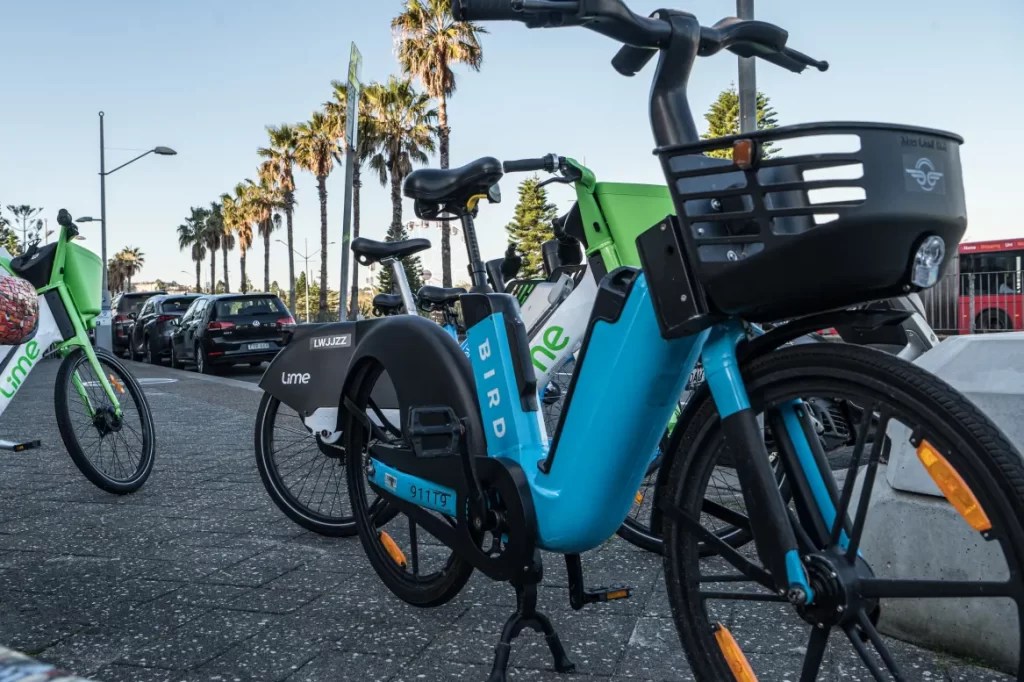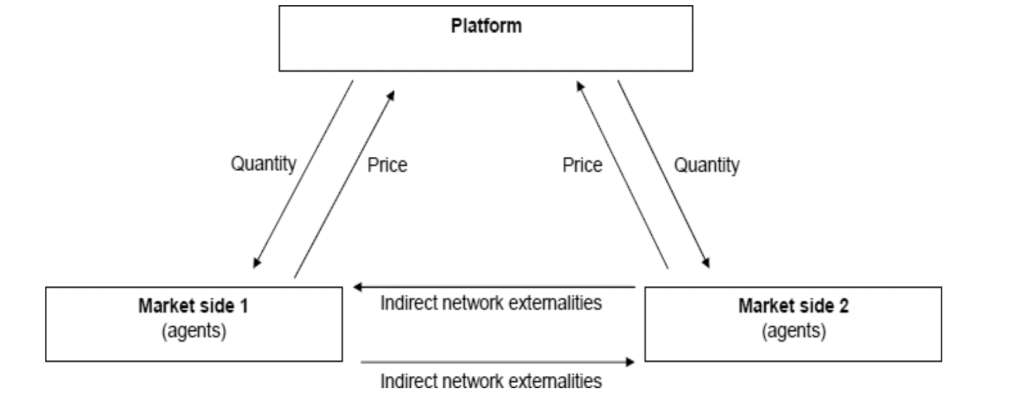
“From car-sharing and bicycle-rental schemes, to sharing stories, habits and tastes across social media, people are increasingly inclined to share.” —- John Nicolas
Transform in the traditional market structure are inseparable from the advancement of digital technology, changing consumer behavior under the influence of digital culture and the convenience and transparency of platforms have promoted the emergence of new business models. The sharing economy, also known as the gig economy and collaborative economy, is defined as the sharing of assets or services between individuals, which utilizes digital platforms to facilitate the distribution and consumption of goods (John, 2006). As the economic recession in 2008 coincided with the rise of the Web 2.0 era, people began to try to obtain benefits from underutilized goods and skills, the sharing economy transformed into a mainstream economic activity and achieved huge benefit growth.
Multi-sided market and sharing economy

“Bike sharing” by Flavio Brancaleone is licensed under CC BY 2.0.
There are diverse operating modes of the sharing economy. In one case, the transaction occurs between the platform and the consumers, such as shared bicycles (Lime, Mobike) provided by the platform to the user. Another situation is, rather than being a trading partner participating, the platform plays the role of a regulator to facilitate transactions between the supply side and the demand side. For services such as Uber Carshare, Uber is just an intermediate platform, and the car is leased from one party to another. The second scenario embodies the multisided markets under the sharing economy, which emphasizes the existence of platforms and the interdependence between different parties. A multi-sided market is defined as a platform that allows multiple different agents to trade, with the elements that 1) two or more groups of participants 2) rely on catalysts (such as platforms) to facilitate value-creating interactions between them 3) the decision of each agent affect the outcomes of other agent through externalities (Yasar et al., 2017). Therefore, the relationship between the sharing economy and the multi-sided market is that sharing economy companies use the business model of multi-sided platforms to act as intermediaries between agents while relying on digital platforms and their indirect network effects to create value for multiple participants.
Dynamic relationship
The main participants in the multi-sided market (at least two market parties and the platforms) maintain a dynamic and interactive relationship, which contributes to the achievement of the sharing economy. Market agents influence each other’s decisions while the platform acts as a mediator and provides services to multiple market parties.
On the one hand, agents influence each other through indirect network effects. More people are required to provide services in the market when more demanders are participating in the sharing economy, the number of a market side will affect the value of products or services to another, thus forming a shared balance system (Lindstädt, 2010). The more drivers Uber has, the more attractive it will be to passengers as it is easier for them to get a ride. Meanwhile, the more people using Uber, the platform will be more attractive for drivers because it is more convenient to gain orders. Therefore, the participants in the multi-side market have their own needs and restrict each other, especially the transaction mode that obtains benefits individually through searching for a win-win balance reflects the essence of sharing.

“multised market” by Dewenter/Haucap is licensed under CC BY 2.0.
On the other hand, the platform plays a role in the externalities that cannot be directly addressed by the market sides. As a coordinator, the platform connects both parties in the market and charges fees appropriately. Compared with offline transactions, online platforms provide ways to minimize transaction costs, such as reducing search costs. In addition, the platform’s pricing strategy sets reasonable prices and quantities for both sides, the asymmetric pricing structure adapts to the different needs of users while making transactions transparent and standardized (Lindstädt, 2010). The platform of the sharing economy not only enhances transactions in the market but also maximizes benefits by creating demand. Therefore, the multi-sided market model is beneficial to both market agents and the platforms.
Case Study: Airbnb
Since the example of Uber was widely used above, the case study focuses on another field of sharing platforms, which is Airbnb. Airbnb allows hosts to rent out their houses online to others in need of affordable accommodation, since 2008, the number of Airbnb rooms has reached 3 million, even surpassing hotel groups such as Hilton (Peng et al., 2022).

On the one hand, Airbnb provides smart pricing tools for landlords to adjust their properties to a price suitable for consumers based on market demand. On the other hand, the smart algorithm allows tenants to find hosts through the searching function and utilize the filter to further meet their expectations. The revenue of Airbnb comes from charging 6%-12% service fees from tenants and 3% service fees from landlords, correspondingly, it makes users willing to pay by reducing information asymmetry among participants (Vienken et al., 2019). Mandatory verification of customer profiles reduces the risk of fraud common online. Tenants and landlords can see each other’s ratings and activity, building varying levels of trust in each other. While Airbnb provides cleaning services to landlords, it also enables residents to enjoy a better living environment. In conclusion, the role of Airbnb in building trust between landlords and tenants reflects the characteristics of the online sharing economy, that is, the importance of the platform in facilitating transactions is admitted.
Role of digital culture
The development of the sharing economy and the maturity of the multi-sided market model are closely related to digital culture. The strengthening of sharing awareness in network culture is one of the prerequisites for the development of the sharing economy. According to John, humans have the innate to share and cooperate, and reciprocal communities are the basis for human survival and evolution (John, 2016). What online culture achieves is to rebuild a sense of community and trust, as humans become more accustomed to sharing based on online media. Therefore, digital culture strengthens the connections between people, thereby laying the foundation for the development of the sharing economy.
In addition, network effects strengthen the interconnections between different parties in multi-sided markets and amplify the growth of the sharing economy. In network effects, the value a user gains from a product or service depends on the number of users in a platform, value always increases with more participants (Yasar et al., 2017). Rather than the development of one party alone, the success of the sharing economy relies on the growth of both parties, which means that there must be enough users to meet the exchange and sharing of goods. The strong dissemination power of information and the diversified user of the internet enables a wider audience, thus reducing transaction costs and improving resource allocation efficiency.
Critical thinking:
can sharing economy always be benefical?
One perspective on the benefits of the sharing economy is that it is difficult for sharing economy companies to form a monopoly because the cost for customers to switch between sharing economy services is quite low. However, some scholars also refute it, as companies can still consolidate their positions through tech lobbying. In addition, when acknowledging the externalities of multilateral markets to achieve win-win outcomes for all parties, vice-externalities may also arise. For example, in the media market, once the audience regards advertising as a distraction, there will likely be more advertisers in the market, but fewer readers will be attracted (Lindstädt, 2010). In general, while the sharing economy promotes sharing, it may also lead to new exploitation. The sharing economy is difficult to supervise, and the gig market lacks welfare guarantees for regular employees. It is impossible to be 100% beneficial to participants.
reference list:
Gürkaynak, G., İnanılır, Ö., Diniz, S., & Yaşar, A. G. (2017). Multisided markets and the challenge of incorporating multisided considerations into competition law analysis. Journal of Antitrust Enforcement, 5(1), 100–129. https://doi.org/10.1093/jaenfo/jnw007
John, N. A. (2016). Sharing Economies.The age of sharing (pp. lviii–lxxvii). Polity.
Lindstädt, N. (2010). Multisided media markets: Applying the theory of multisided markets to media markets. Zeitschrift Für Wettbewerbsrecht: Journal of Competition Law, 8(1), 53–80. https://doi.org/10.15375/zwer-2010-0104
Qiu, H., Li, Q., Lin, P., & Peng, K.-L. (2022). Factors determining the disruption from sharing economy: evidence from Airbnb in China. Current Issues in Tourism, 25(21), 3401–3411. https://doi.org/10.1080/13683500.2020.1832970
Vienken, C., Abdelkafi, N., & Tangour, C. (2019). Multi-sided Platforms in the Sharing Economy – A Case Study Analysis for the Development of a Generic Platform. Digital Economy: Emerging Technologies and Business Innovation (pp. 373–386). Springer International Publishing. https://doi.org/10.1007/978-3-030-30874-2_29


Be the first to comment on "Win-win Situation: Dynamic Relationship of Multi-sided Market in Sharing Economy"